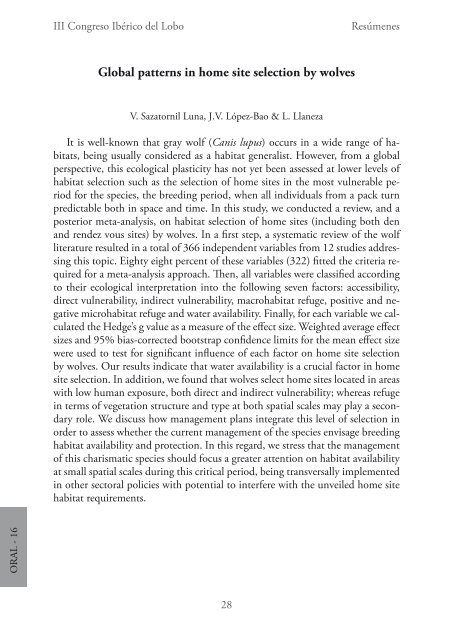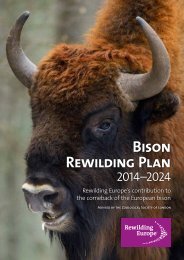III Congreso Ib%C3%A9rico del Lobo
III Congreso Ib%C3%A9rico del Lobo
III Congreso Ib%C3%A9rico del Lobo
Create successful ePaper yourself
Turn your PDF publications into a flip-book with our unique Google optimized e-Paper software.
ORAL - 16<br />
<strong>III</strong> <strong>Congreso</strong> Ibérico <strong>del</strong> <strong>Lobo</strong> Resúmenes<br />
Global patterns in home site selection by wolves<br />
V. Sazatornil Luna, J.V. López-Bao & L. Llaneza<br />
It is well-known that gray wolf (Canis lupus) occurs in a wide range of habitats,<br />
being usually considered as a habitat generalist. However, from a global<br />
perspective, this ecological plasticity has not yet been assessed at lower levels of<br />
habitat selection such as the selection of home sites in the most vulnerable period<br />
for the species, the breeding period, when all individuals from a pack turn<br />
predictable both in space and time. In this study, we conducted a review, and a<br />
posterior meta-analysis, on habitat selection of home sites (including both den<br />
and rendez vous sites) by wolves. In a first step, a systematic review of the wolf<br />
literature resulted in a total of 366 independent variables from 12 studies addressing<br />
this topic. Eighty eight percent of these variables (322) fitted the criteria required<br />
for a meta-analysis approach. Then, all variables were classified according<br />
to their ecological interpretation into the following seven factors: accessibility,<br />
direct vulnerability, indirect vulnerability, macrohabitat refuge, positive and negative<br />
microhabitat refuge and water availability. Finally, for each variable we calculated<br />
the Hedge’s g value as a measure of the effect size. Weighted average effect<br />
sizes and 95% bias-corrected bootstrap confidence limits for the mean effect size<br />
were used to test for significant influence of each factor on home site selection<br />
by wolves. Our results indicate that water availability is a crucial factor in home<br />
site selection. In addition, we found that wolves select home sites located in areas<br />
with low human exposure, both direct and indirect vulnerability; whereas refuge<br />
in terms of vegetation structure and type at both spatial scales may play a secondary<br />
role. We discuss how management plans integrate this level of selection in<br />
order to assess whether the current management of the species envisage breeding<br />
habitat availability and protection. In this regard, we stress that the management<br />
of this charismatic species should focus a greater attention on habitat availability<br />
at small spatial scales during this critical period, being transversally implemented<br />
in other sectoral policies with potential to interfere with the unveiled home site<br />
habitat requirements.<br />
28



